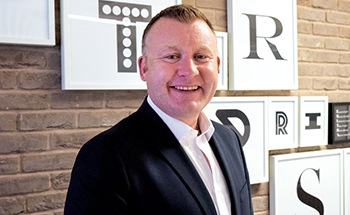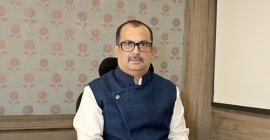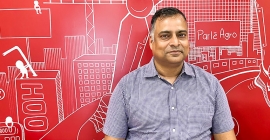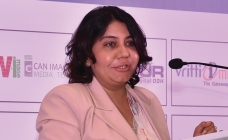‘OOH has a key role to play in lifting the nation’s spirits’
By Rajiv Raghunath - November 03, 2020
Phil Hall, Joint Managing Director, Ocean Outdoor talks about the UK OOH major’s decisive business approach in the face extreme adversity posed by Covid-19 fallout
OOH advertising was perhaps the hardest hit among all media channels by the fallout of the pandemic. How has Ocean Outdoor tackled the business challenges in this period? Are you seeing a revival of OOH business prospects in the UK now?
If you were to compile a list of the events most likely to negatively impact an OOH business, a nationwide government lockdown would have to be pretty near the top. However, that’s exactly what we faced in the UK on the 23rd March. Our Q2 revenue virtually disappeared overnight and the immediate task was to move booked activity back into Q3 and Q4 and reassure advertisers whilst we waited for more positive news.
 There were two business priorities during this time. The first was to secure the financial future of Ocean and to ensure the short-term effect on revenues didn’t put the medium and long-term future of the business in jeopardy. This was achieved early on in the crisis, a testament to the upward trajectory of Ocean pre-COVID. The second priority was ‘not going dark’. The last thing we wanted to do was to have blank screens or screens playing out generic ‘fillers’. Instead we immediately committed to making our screens a force for good. We displayed safety messaging, thanked key workers on behalf of the people and turned our screens blue to celebrate the work of our National Health Service. When our Queen addressed the nation we displayed an extract of her speech on the most famous OOH site in the world – the Piccadilly Lights, garnering a huge amount of media exposure. We turned to the Lights again to publicise a rare ray of light in the lockdown darkness. As he approached his 100th birthday, retired army captain Tom Moore attempted to raise £1,000 for the NHS by walking laps of his garden. With the British public behind him he ended up raising a staggering £32.8m and his achievement was celebrated at Piccadilly.
There were two business priorities during this time. The first was to secure the financial future of Ocean and to ensure the short-term effect on revenues didn’t put the medium and long-term future of the business in jeopardy. This was achieved early on in the crisis, a testament to the upward trajectory of Ocean pre-COVID. The second priority was ‘not going dark’. The last thing we wanted to do was to have blank screens or screens playing out generic ‘fillers’. Instead we immediately committed to making our screens a force for good. We displayed safety messaging, thanked key workers on behalf of the people and turned our screens blue to celebrate the work of our National Health Service. When our Queen addressed the nation we displayed an extract of her speech on the most famous OOH site in the world – the Piccadilly Lights, garnering a huge amount of media exposure. We turned to the Lights again to publicise a rare ray of light in the lockdown darkness. As he approached his 100th birthday, retired army captain Tom Moore attempted to raise £1,000 for the NHS by walking laps of his garden. With the British public behind him he ended up raising a staggering £32.8m and his achievement was celebrated at Piccadilly.
We proved that OOH has an important role to play in lifting the nation’s spirits, even when everyone is indoors. We didn’t just concentrate on feel-good, though it was important that we demonstrated the brand-building power of OOH too. As such we committed to supporting small and medium sized enterprises (SMEs) by creating a fund of £10m of free space on our screens. Most of these businesses were new to advertising and all were struggling in the economic devastation wreaked by the virus. We ended up donating £17m of space to these SMEs, helped local economies and communities across England and Scotland and received some fantastic testimonials – and new business leads!
At a time when OOH could easily have disappeared from view we’re proud of the way we used our iconic screens to help the nation.
Iconic and spectacular media are high investment businesses. Today, as advertising brands are having to work with tighter budgets, would they sustain their interest in using spectacular media?
They are high investment businesses because they fulfil a very important role for advertisers. There has been so much emphasis over the last few years on the bottom of the marketing funnel – using digital media to prompt the consumer and facilitate purchase. In these tough economic times it’s tempting to pursue the apparent high RoI this strategy delivers, but there is a wealth of evidence out there showing that one of the key drivers of efficient conversion is a strong brand. As TV viewing becomes more fragmented there is a very strong argument to say that OOH becomes even more vital as a mass brand-builder. People will consume media in ever more personal ways and will guard their privacy and resist advertising over content. The challenge of reaching relevant and engaged audiences at scale will only grow, but so long as people are outside then iconic and spectacular OOH will be high impact, unavoidable and unskippable.
It’s interesting to see the digital giants such as Google, Facebook and Tik Tok being some of the strongest supporters of OOH in the UK, especially around the more high-profile sites. These are clients with more data and insight on customers than anyone else and the spending power to buy exactly what they want. And they’re choosing iconic OOH.
Social sharing of OOH is a final factor to consider. Our two most iconic sites are Piccadilly Lights and the BFI IMAX. The creative work on both these sites is regularly shared, by the clients themselves and members of the public. There is a huge value to this sharing and, with the right creative, the social value alone can exceed the price of the OOH advertising, leading to mass awareness in a quality location for incredible value.
Ocean was spreading out geographically in 2019. Would you consider any business expansions in the coming months, keeping in view the overall business environment?
We were expanding rapidly pre-COVID, with acquisitions in the Nordics and the Netherlands and new contract wins and development across the UK. Our positioning is around “Digital Cities for Digital Citizens’, using DOOH as a way to improve the infrastructure of the cities where we have a footprint. From a development point of view that won’t change but it’s likely that we’ll be even more selective about what and where we build. We have to be customer-led, developing where our partners and clients indicate that existing levels of cover are low and there are opportunities to add value.
Do you see the business of OOH advertising changing in the wake of the Covid-19 crisis, and what is the likely contour of the new OOH landscape in the making?
I think all media will change to some extent but OOH more than most, which makes sense given the severity of the initial effect. The silver lining on the cloud of COVID has been the acceleration of automation and technology on both the buy and sell side over the last six months. I think the industry in the UK is around 3-4 months ahead of where it would otherwise have been and that’s a real positive as we move forward. We have also seen the relaxing and removal of some of the old rules around how OOH is traded and this combined with the technological capabilities will change our industry.
The most obvious change will be a sell against audiences rather than panels. The timing for this change is perfect – in this climate advertisers need to be reassured that they’re paying for the audience they’re getting and a Cost Per Thousand metric is the best and most transparent way to do this. The days of the two week in-charge period are also numbered on all but a small amount of sites. Advertisers will be able to set parameters around a wealth of data points and we will activate their campaigns when conditions are most optimal.
In the past OOH has sometimes suffered from low scores in an Econometrics / Business Science world. I suspect this will change dramatically in the near future. If there is an advertiser who makes a high proportion of their sales in a Westfield mall on a Saturday morning, that’s where we should concentrate the advertising on our screens, not giving equal weight to, say a Tuesday afternoon. The more bespoke an advertiser wants to be, the higher the price, but initial results have shown this is dwarfed by the increased efficiency in reaching the right audience.
Are you also seeing more technologies coming into OOH advertising, especially DOOH?
At Ocean we have always embraced new technology and through our annual Creative Competition, have helped to pioneer the use of technologies such as VDT (Vehicle Detection Technology) and Live Content Streaming which are now used on a National scale within the UK DOOH market.
In May, reacting to COVID, we announced a new partnership with Ultraleap to deploy their mid-air haptics technology across Ocean screens in key experiential spaces, replacing touch-screen activity with displays and interfaces which are triggered by natural hand interactions, allowing audiences to trigger or control screen content using hand gestures instead of touch surfaces.
More recently, with advertisers and agencies demanding more flexibility than ever before, we’ve been quick to adopt new Programmatic and Automated trading tools, which allow advertisers to transact in near real-time, using live data and real-world events to trigger campaigns. This has opened up an exciting new route to market for advertisers and keeps Ocean at the forefront of the DOOH market.
I think there’s something of a lag in perception around DOOH in particular, especially when it comes to large format digital screens and what is possible. I’m from a media agency background and I think one of our challenges, as Ocean and as an industry, is to ensure the huge strides forward that DOOH has made in the last few years are recognised. Ocean have always had super-premium screens in great locations, but we now use those screens to serve advertising to specific vehicles, to recognise people’s moods and serve relevant messaging, to allow interaction and game playing and to showcase world-class content (from the Olympics to Wimbledon tennis to London Fashion Week and much more beside). This adds up to an engaging, brand-safe, high-quality, mass-reach channel. I can’t think of any advertisers who won’t want to be a part of that and it’s the reason I’m so optimistic about the future of OOH and Ocean Outdoor.

Stay on top of OOH media trends








